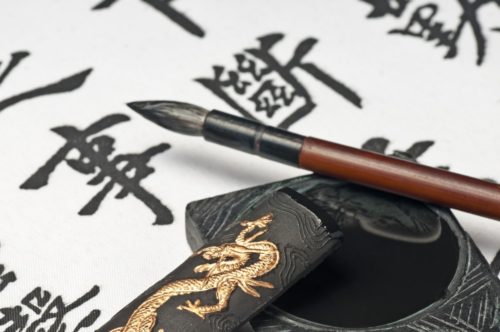Some language stuff
We’ve got a few proper nouns here. We have the name of a painter Zhang Sengyao (张僧繇 – my pinyin generator erroneously translates “yao” as “you”), a city called Jinling 金陵, which is present-day Nanjing (南京), and Anle Temple (安乐寺). Since 乐 can be pronounced both lè and yuè, I had to look this one up – apparently it’s lè.
顷刻间 qǐng kè jiān – A word worth noting, since it’s not used too often: this means “in an instant”.
腾空而去 téng kōng ér qù – This one is notable because of the 而去. The 而 here is used to describe the manner in which one is leaving (去). This construction is pretty common. There’s 拂袖而去, or “to turn on one’s heels and go” / “to leave abruptly”; there’s 悠然而去, or “to leisurely take one’s leave”; 哄然而去, or “to leave boisterously”. You can also use other words like 走 after the 而 to describe how someone is moving forward, like 沿江而走, or “to travel on following the river”, or 不胫而走, “to get around fast / spread like wildfire”. In this case, 腾空 means to rise into the air, so 腾空而去 means to “lift off into the air (and leave)”.
两条巨龙转动着光芒四射的眼睛冲天而起 – Now that we understand 而去, we can tackle this beast of a clause. First, the subject of the sentence: 两条巨龙, two giant dragons. Then, a present-tense verb: 转动着, in this case “rotating” or “moving around in a circular or twisting motion”. What is moving around in a circular motion? That would be the dragon’s 眼睛 – their eyes. What kind of eyes do they have? They have 光芒四射的 eyes, or “radiating beams of light”. The hard part in translating this is really 转动着, because in English we don’t describe eyes as “revolving / twisting”. But you can kind of get the idea that the eyes of these two dragons are sweeping around as they look all about themselves, and their eyes are shooting beams of lights as they look around. Finally, we have 冲天而起 – 冲天, to charge towards the sky, and 而, “the manner in which something is done”, and 起, to rise up. So the two dragons (两条巨龙) rise charging into the sky (冲天而起) casting about with beams of light shooting from their eyes (转动着光芒四射的眼睛). Whew.
画龙点睛
传说古时候有个画家叫张僧繇,他画龙画得特别好。
有一次,他在金陵(现在南京)安乐寺的墙壁上画了四条巨龙,那龙画得活灵活现,非常逼真,只是都没有眼睛。人们问张僧繇:“为什么不把眼睛画出来?”
他说:“眼睛可不能轻易画呀!一画了,龙就会腾空飞走的!”
大家听了,谁也不信,都认为他在说大话。后来,经不起人们一再请求,张僧繇只好答应把龙的眼睛画出来。奇怪的事情果然发生了,他刚刚点出第二条龙的眼睛,突然刮起了大风,顷刻间电闪雷鸣。两条巨龙转动着光芒四射的眼睛冲天而起,腾空而去。围观的人,个个看得目瞪口呆,对张僧繇更佩服了。




